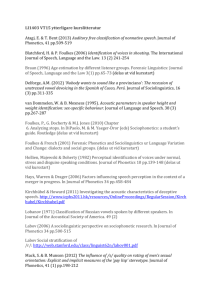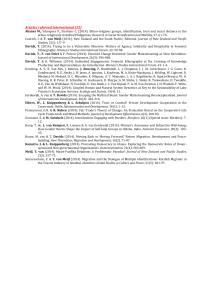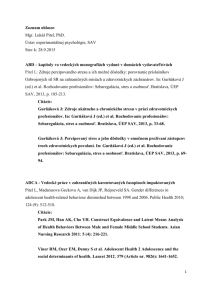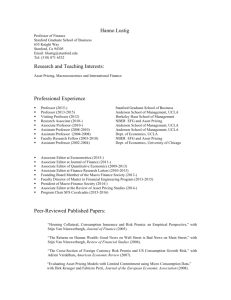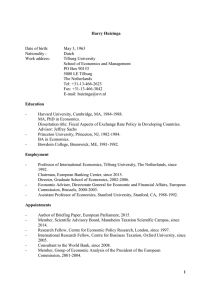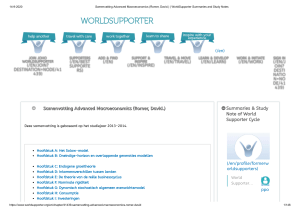ders planı
advertisement
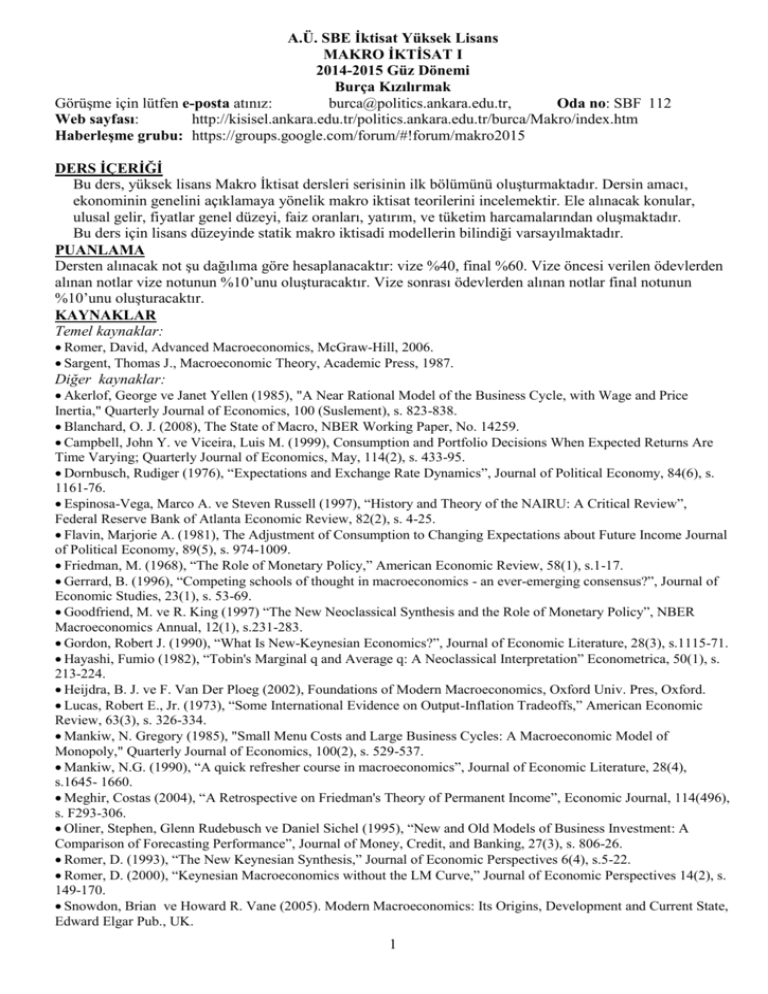
A.Ü. SBE İktisat Yüksek Lisans MAKRO İKTİSAT I 2014-2015 Güz Dönemi Burça Kızılırmak Görüşme için lütfen e-posta atınız: burca@politics.ankara.edu.tr, Oda no: SBF 112 Web sayfası: http://kisisel.ankara.edu.tr/politics.ankara.edu.tr/burca/Makro/index.htm Haberleşme grubu: https://groups.google.com/forum/#!forum/makro2015 DERS İÇERİĞİ Bu ders, yüksek lisans Makro İktisat dersleri serisinin ilk bölümünü oluşturmaktadır. Dersin amacı, ekonominin genelini açıklamaya yönelik makro iktisat teorilerini incelemektir. Ele alınacak konular, ulusal gelir, fiyatlar genel düzeyi, faiz oranları, yatırım, ve tüketim harcamalarından oluşmaktadır. Bu ders için lisans düzeyinde statik makro iktisadi modellerin bilindiği varsayılmaktadır. PUANLAMA Dersten alınacak not şu dağılıma göre hesaplanacaktır: vize %40, final %60. Vize öncesi verilen ödevlerden alınan notlar vize notunun %10’unu oluşturacaktır. Vize sonrası ödevlerden alınan notlar final notunun %10’unu oluşturacaktır. KAYNAKLAR Temel kaynaklar: Romer, David, Advanced Macroeconomics, McGraw-Hill, 2006. Sargent, Thomas J., Macroeconomic Theory, Academic Press, 1987. Diğer kaynaklar: Akerlof, George ve Janet Yellen (1985), "A Near Rational Model of the Business Cycle, with Wage and Price Inertia," Quarterly Journal of Economics, 100 (Suslement), s. 823-838. Blanchard, O. J. (2008), The State of Macro, NBER Working Paper, No. 14259. Campbell, John Y. ve Viceira, Luis M. (1999), Consumption and Portfolio Decisions When Expected Returns Are Time Varying; Quarterly Journal of Economics, May, 114(2), s. 433-95. Dornbusch, Rudiger (1976), “Expectations and Exchange Rate Dynamics”, Journal of Political Economy, 84(6), s. 1161-76. Espinosa-Vega, Marco A. ve Steven Russell (1997), “History and Theory of the NAIRU: A Critical Review”, Federal Reserve Bank of Atlanta Economic Review, 82(2), s. 4-25. Flavin, Marjorie A. (1981), The Adjustment of Consumption to Changing Expectations about Future Income Journal of Political Economy, 89(5), s. 974-1009. Friedman, M. (1968), “The Role of Monetary Policy,” American Economic Review, 58(1), s.1-17. Gerrard, B. (1996), “Competing schools of thought in macroeconomics - an ever-emerging consensus?”, Journal of Economic Studies, 23(1), s. 53-69. Goodfriend, M. ve R. King (1997) “The New Neoclassical Synthesis and the Role of Monetary Policy”, NBER Macroeconomics Annual, 12(1), s.231-283. Gordon, Robert J. (1990), “What Is New-Keynesian Economics?”, Journal of Economic Literature, 28(3), s.1115-71. Hayashi, Fumio (1982), “Tobin's Marginal q and Average q: A Neoclassical Interpretation” Econometrica, 50(1), s. 213-224. Heijdra, B. J. ve F. Van Der Ploeg (2002), Foundations of Modern Macroeconomics, Oxford Univ. Pres, Oxford. Lucas, Robert E., Jr. (1973), “Some International Evidence on Output-Inflation Tradeoffs,” American Economic Review, 63(3), s. 326-334. Mankiw, N. Gregory (1985), "Small Menu Costs and Large Business Cycles: A Macroeconomic Model of Monopoly," Quarterly Journal of Economics, 100(2), s. 529-537. Mankiw, N.G. (1990), “A quick refresher course in macroeconomics”, Journal of Economic Literature, 28(4), s.1645- 1660. Meghir, Costas (2004), “A Retrospective on Friedman's Theory of Permanent Income”, Economic Journal, 114(496), s. F293-306. Oliner, Stephen, Glenn Rudebusch ve Daniel Sichel (1995), “New and Old Models of Business Investment: A Comparison of Forecasting Performance”, Journal of Money, Credit, and Banking, 27(3), s. 806-26. Romer, D. (1993), “The New Keynesian Synthesis,” Journal of Economic Perspectives 6(4), s.5-22. Romer, D. (2000), “Keynesian Macroeconomics without the LM Curve,” Journal of Economic Perspectives 14(2), s. 149-170. Snowdon, Brian ve Howard R. Vane (2005). Modern Macroeconomics: Its Origins, Development and Current State, Edward Elgar Pub., UK. 1 DERS PROGRAMI I. GİRİŞ Zorunlu: Mankiw, 1990; Gerrard, 1996 Diğer: Snowdon ve Vane, 2005 TEMEL OKULLAR II. KLASİK MODEL Zorunlu: Sargent, bölüm 1.6 Diğer: Heijdra ve Van Der Ploeg, 2002. III. KEYNESYEN MODEL Zorunlu: Sargent, bölüm 2.1, Romer, bölüm 5 Diğer: Dornbush, 1976; Espinosa-Vega ve Russell, 1997, Sargent 5.1, Goodfriend ve King, 1997; Romer, 2000; Heijdra ve Van Der Ploeg, 2002. 1. 2. 3. 4. 5. IS-LM Modeli Açık Ekonomi Phillips Eğrisi Doğal İşsizlik Oranı Yeni Phillips Eğrisi MİKRO EKONOMİK TEMELLER IV. YENİ KLASİK OKUL (Lucas Modeli) Zorunlu: Romer, bölüm 6A Diğer: Lucas, 1973; Friedman, 1968 V. YENİ KEYNESYEN OKUL Zorunlu: Romer, bölüm 6B-C Diğer: Gordon, 1990; Akerlof ve Yellen, 1985; Mankiw, 1985; Romer, 1993; Blanchard, 2008 1. Etiketleme Maliyetleri (Menu Costs) 2. Eşgüdüm Bozukluğu 3. Aşamalı Fiyat Uyumu DAVRANIŞSAL TEMELLER VI. TÜKETİM Zorunlu: Romer, bölüm 7 Diğer: Meghir, 2004; Flavin, 1981; Campbell ve Viceira, 1999 1. Daimi Gelir Hipotezi 2. Rastlantısal Yürüyüş Hipotezi 3. CAPM modeli 4. Alternatif Yaklaşımlar VII. YATIRIM Zorunlu: Romer, bölüm 8 Diğer: Hayashi, 1982; Oliner, Rudebusch ve Sichel, 1995 1. Uyum Maliyetleri 2. Tobin q 3. Belirsizliğin Etkisi 4. Mali Piyasa Aksaklıkları 2
